13 Implementation
This section has covered some specific concerns about branding and communication for course marking initiatives. This chapter will dive into the communication process for a course markings initiative, from pre- to post-launch. The considerations and examples here are presented to serve initiative coordinators as they brainstorm plans for marketing for their course markings initiative.
Pre-Launch
The initiative coordinator should first consult the administration on campus before reaching out to other departments about marking courses. At this meeting, coordinators should prepare a pitch and an explanation of the benefits of open and affordable course markings for students, instructors, and the university. Chapter 6 (Talking Points) discusses how to assemble the pros and cons for presentation to campus shareholders and decision makers. The “big picture” plan—where open and affordable course markings are found, how they look, and who can see them—should be approved by the administration throughout the design and implementation process. This support can be leveraged later on when sharing information about the markings. Administrators are important partners for marketing campaigns because they have access to campus-wide mailing lists and high-level meetings that the markings implementation team may not be able to access.
Central advising center staff, division/department advising staff, and any other staff members who are in a position to help students select courses should receive regular messaging about the course materials affordability initiative and course markings throughout the implementation process. These partners will be incredibly useful both at the beginning of the course marking initiative as plans for integrating markings are made and later on when students begin to ask questions about what the markings mean.
As discussed in the Section I (Policy), in some states, open and affordable course markings are being implemented due to a legislative mandate. For example, in Texas, SB 810 requires state colleges to institute course markings for courses that use open or affordable resources. Explaining that the open and affordable course markings are being implemented because of a law can help mitigate pushback; however, it is also important to emphasize the benefits of course markings.
Before the open and affordable course markings are officially launched, coordinators prepare frequently asked questions (FAQs) and marketing materials that can be used to explain and justify the initiative’s goals. Additionally, it is important to ensure that all members of the initiative team are well versed on what is happening, where, and why so they can answer questions effectively. A great example of a static FAQ page is the one provided by California State University’s Affordable Learning Solutions (California State University n.d.; fig 13.1). The webpage FAQ makes it clear what the benefits of the open and affordable course markings are and why they are being implemented, stating that “our goal is to support as many students as possible in saving on the cost of their education by utilizing the large array of low and no-cost resources readily available” (para. 5).
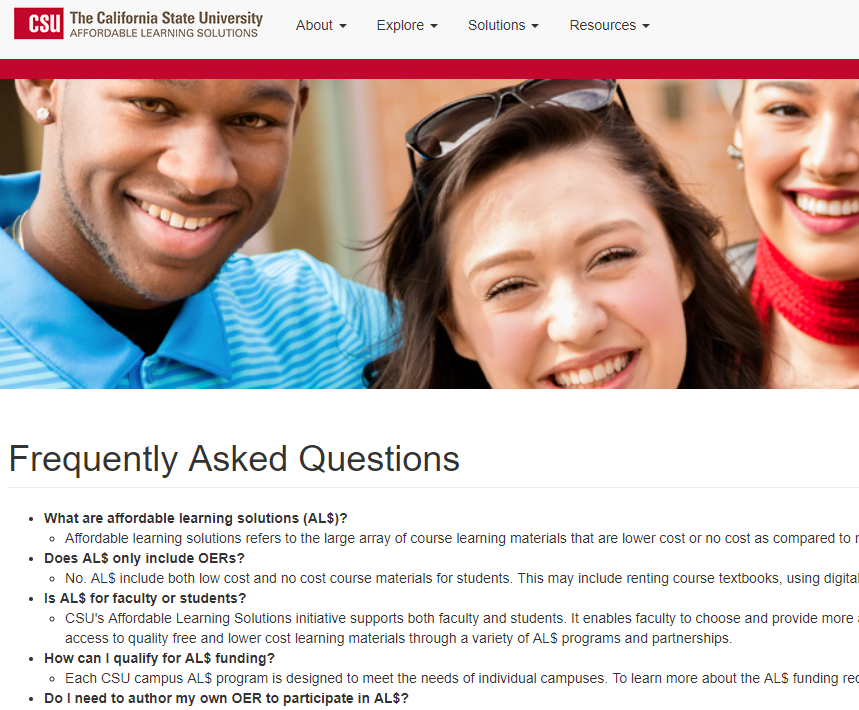
Communicating with instructors
When planning pre-launch communication strategies for reaching instructors, the coordinators for the open and affordable course markings initiative should consider a variety of venues and channels. Instructors can be valuable contributors to the crafting of the language used in messaging during this stage. If they are not already major partners in the institution’s course materials affordability movement, involving faculty in this step of the campaign can also help by increasing buy-in. An effective combination may include multiple forms of communication.
Communications Strategies for Reaching Instructors
Electronic Communication
- Faculty-wide emails
- Electronic newsletters and announcements
- Webpages and FAQs about the new system
- Video tutorials and walk-throughs about the marking process
In-Person Communication
- Open forums and Q&As about the new system
- Meetings with deans and department heads
- Presentations at faculty senate and department-level meetings
- Training for faculty change-makers (instructors who are high profile and will champion the course markings)
Material Communication
- Door hangers
- Posters and signage in department offices
- Small handouts (bookmark or postcard-sized) deployed throughout campus
One major component of communication with faculty will be soliciting instructors who are already using open and affordable resources to quickly adopt the open and affordable course markings upon launch (or even prior, depending on the launch strategy). Thus, some messaging for instructors will need to appeal to those who may not know what open educational resources (OER) are, even when the instructor may already use OER in their classroom. For pre-launch messaging to instructors who are wholly unfamiliar with open and affordable resources, the coordinators of the open and affordable course markings initiative should center communications on the benefits as they relate to department and campus goals (e.g., retention, success, graduation, and basic needs) as well as student success. It’s also helpful to employ data from local contexts in addition to research from larger OER initiatives and organizations to demonstrate the potential impact for students.
Implementation teams will also need to address how to communicate the process by which instructors will submit their course materials and under what criteria materials will be ruled as low-cost or OER. As mentioned in Chapter 8 (Processes), the process for instructors’ use of open and affordable course markings should be as implicit and streamlined as possible. A good example of a streamlined process can be found in the case study of Houston Community College. These instructions will vary based on the system being used to share course markings, so coordinators will need to work with the staff members that manage their student information system (SIS) to learn what can be done at their institution. See Chapter 9 (Student Information Systems).
As implementation teams are reaching out to instructors on campus, they will need to be prepared to address concerns about open and affordable course markings as they arise, having a coherent communications plan in place for different campus entities, and plans for communicating with stakeholders as the course markings initiative nears launch.
Launch
The official launch announcement is an exciting time. Major stakeholders will already know about the course markings by now, but new instructors, transfer students, and other individuals on campus may still be confused about the changes to course material reporting and how the markings in the course schedule work.
Working with instructors
Making sure instructors are on board with course designations before the markings go live is an integral step to the process of marketing a new initiative; however, keeping that momentum going during launch and ensuring that instructors report their OER adoptions and affordable resource use is also incredibly important.
Initiative coordinators can ensure that the launch announcements sent out to instructors explain the initiative concisely, while also making clear that these announcements are not the first time that the course markings have been mentioned. For example, Kansas State University released information sessions for faculty and university news articles to communicate information about their new student fee and course icon (fig 13.2). Faculty should be aware of the course markings project by now, but some will not be. Coordinators will need to be prepared for questions as these communications are shared out.
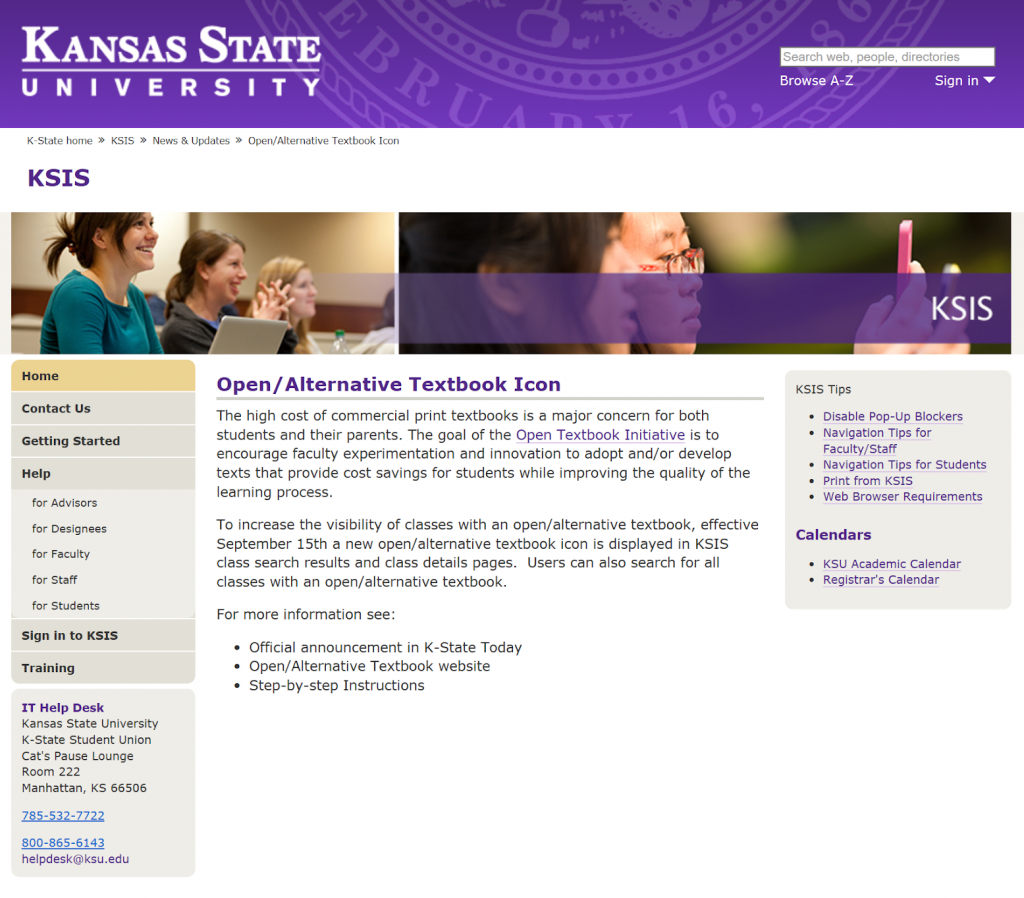
As the changes are put in place, continue to build buy-in from instructors by explaining why these changes were made, pointing to the marketing materials created earlier, and setting up meetings between faculty and members of the markings team. When concerns arise that cannot be addressed in the existing marketing materials, do not panic. Answer the question with what information is available, and make it clear that the initiative and support around it will evolve and grow over time.
Initiative coordinators and marking teams will need to continue to make themselves visible on campus and ensure that the marketing materials and branding continue to be used after the launch phase has ended. Keeping up awareness of the markings will help increase reporting and compliance in the future.
Talking to Students
The ultimate goal of an open and affordable course designation and search in an institution’s course schedule is for students to use the designation to make informed choices about their courses. Marketing targeted at students will already be prepared prior to the course marking launch, but institutions will also need to plan for a sustained marketing effort as new students enter the institution each semester.
Marketing to students should focus on the basics: what the markings mean and how to use them. A great example of this type of video tutorial (Jhangiani 2019b) can be found from Kwantlen Polytechnic University. This is particularly important when technical and financial barriers result in solutions that are not easily discoverable. At the University of Texas at Arlington (UTA), for example, free and low-cost educational resource search filters were added to the schedule of classes in an inconspicuous location—within the system’s advanced search drop-down menu under Course Attribute, as shown in the PeopleSoft section of Chapter 9, where they appear alongside other attributes such as “Honors Course” and “Lab Safety Training Required.” Technically, the search filters were easy to apply to the attribute field.
However, the lack of visibility necessitated a marketing campaign targeting students to make them aware that the attribute existed. UTA Libraries worked with student government representatives to create a flyer presenting steps for using the free and low-cost filters (fig. 13.3), which can be downloaded from the Open for UTA Students guide (Reed 2018).
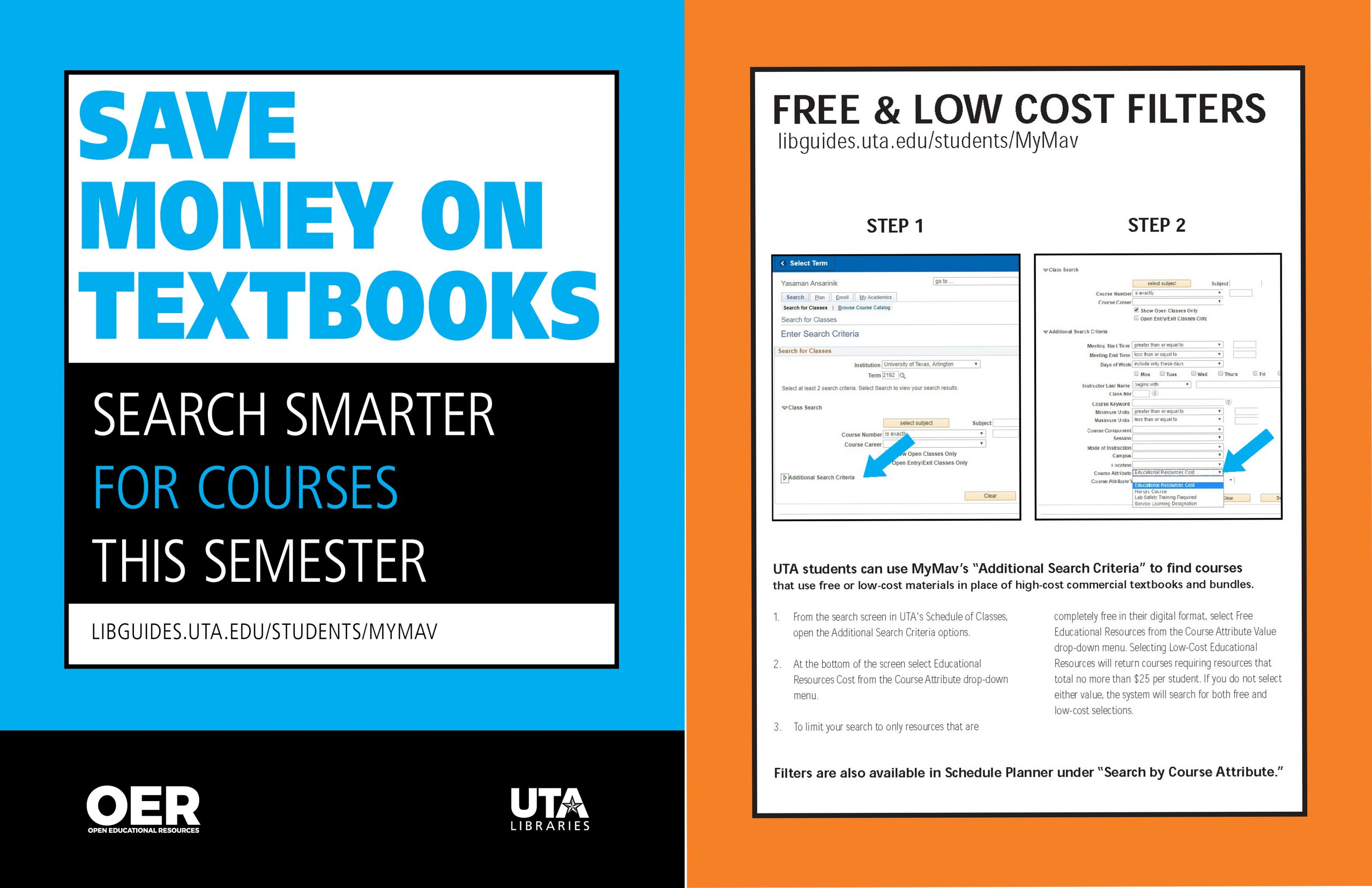
The flyer is printed and disseminated to students and advisers during orientation and registration periods. Additionally, UTA libraries, along with partners in advising and money management, display information about the filters on digital monitors (fig. 13.4), via social media channels (fig. 13.5), and in student-facing newsletters (fig. 13.6) at key periods throughout the semester.
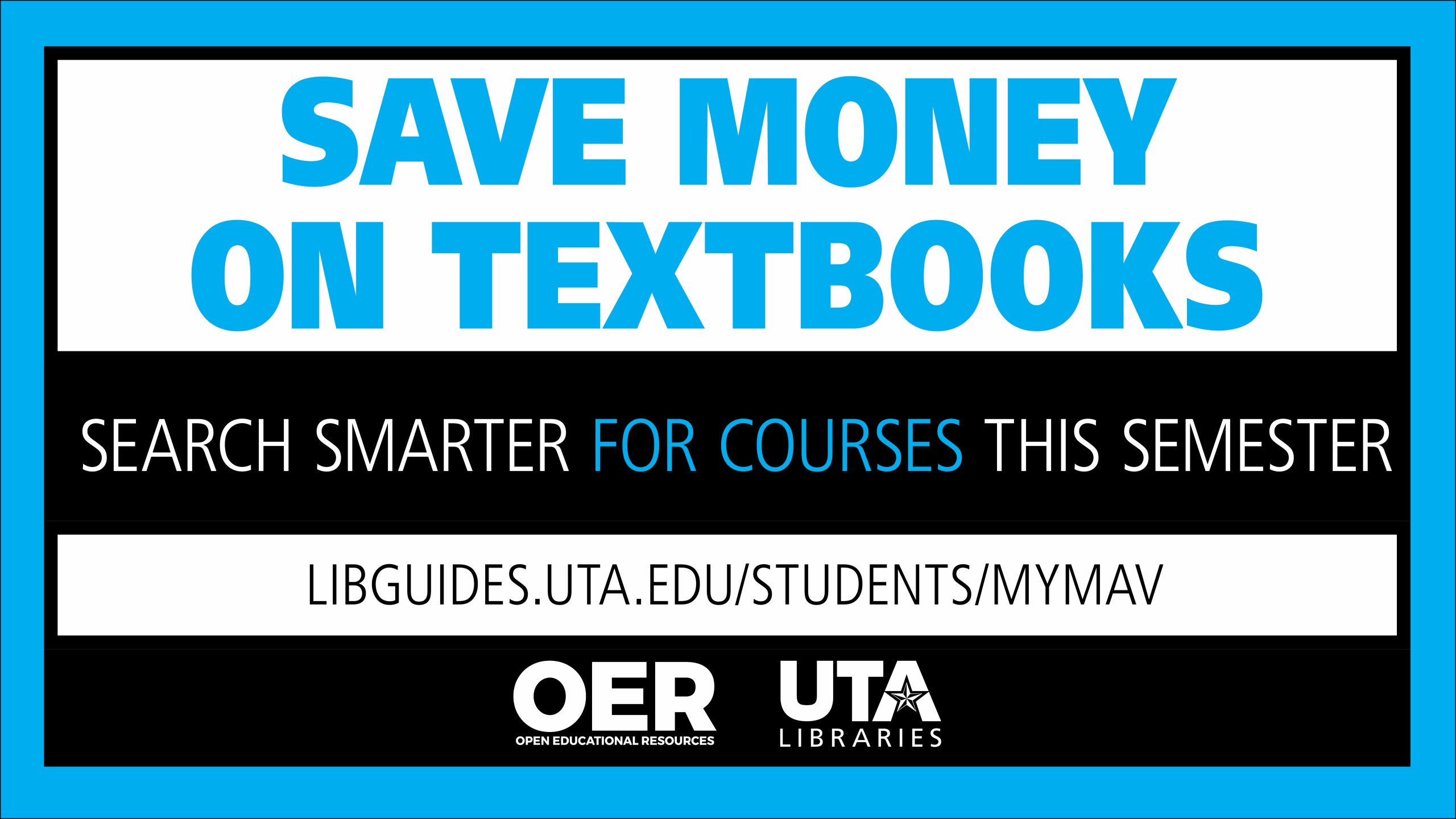

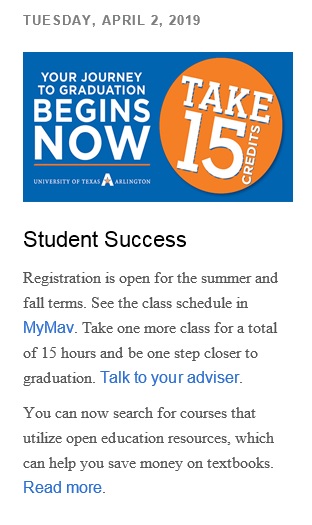
To reach the most students possible, teams should plan and execute a variety of marketing tactics to highlight the open and affordable course designation. Some suggestions include:
- Incorporate information and training about the designation in student orientations and any other events where students are learning to use the class schedule.
- Present to the student government association or and request their help in marketing the effort to students through their communication channels.
- Pitch articles or run advertisements in student newspapers and other publications throughout the year about the open and affordable course designation.
- Present to departments that regularly interact with students around course selection, finances, and course materials. Admissions, advising, and financial aid departments are good places to start, as well as the campus store.
- Print flyers that are distributed to students through various student support departments such as admissions, advising, financial aid, and student life.
- Print posters and flyers to disseminate around the campus.
- Present to campus residential assistants (RAs) and request they help market the effort through their communication channels.
After the initial push, the communications plan will transition to more of an ongoing, sustainable flow of marketing and promotion (as opposed to the launch-focused nature it may have started with).
Post-Launch
Instructors, staff, and administrators will be major audiences for the ongoing promotion of the open and affordable course markings. Messaging should be prepared for returning instructors, particularly leading up to their course submission and textbook selection deadlines. New instructors will need to receive messaging via orientations, emails, or one-on-one meetings (likely in combination). An example of post-launch communications targeted at faculty is the Long Beach Community College (n.d.) faculty resource page on marking courses. This site includes contact information for support staff, descriptions of each marking that faculty can apply to their course, and a link to update a course to include an appropriate marking (fig. 13.7).
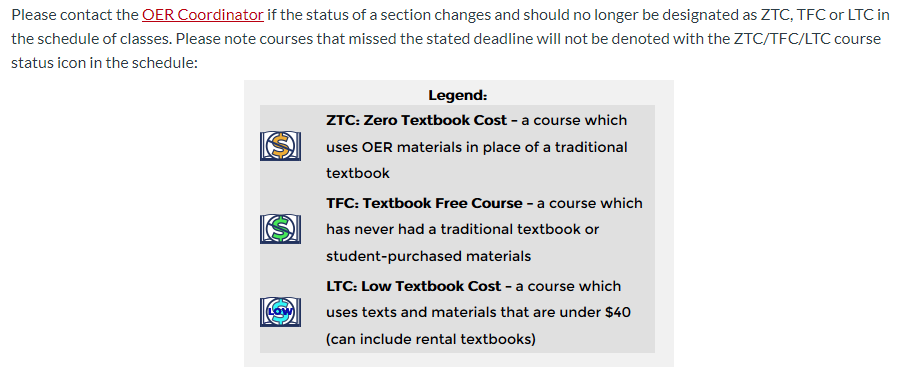
As more instructors adopt OER or low- or no-cost resources and use the course markings, consider adopting a promotional campaign to highlight adopters. Keep this kind of campaign updated with new content regularly delivered via a variety of mediums. Faculty champions can help improve the marketing strategy through feedback and advice for updates over time.
Administrators throughout campus should also be included in the ongoing communications plan. Find ways to regularly communicate the story of the course markings initiative. Include both quantitative elements (e.g., number of courses using open or affordable resources, number of dollars saved by such courses since launch) and qualitative (e.g., testimonials from instructors about how adoption has changed their teaching, testimonials from students about how low/no-cost textbook courses have changed their student experience). Consider working with department heads to continually promote the course markings to their departments and keep faculty abreast of changes over time.
Communication Considerations
Create a plan and designate a person who is responsible for continually updating and maintaining the campaign each semester and each year so new students and instructors are aware of the search function and designation. Questions to consider:
Considerations for Communication with Faculty, Staff, and Administrators
- How often should the implementation team report to administrators about the course marking initiative?
- How often should marketing materials be updated with new text or graphics? Will this timeline be different for physical and electronic media?
- How often should department presentations be given about the course marking initiative?
- Who will update FAQs, webpages, and other online resources related to the course markings?
- Who will send updates to staff in information technology, the registrar’s office, financial aid, and other campus offices if the marking process changes?
- Who will coordinate and run training for instructors who have questions about the course marking process?
Considerations for Communication with Students
- Who will check-in with those running student orientations to ensure the designation and search function are still a part of student orientations and other training opportunities?
- How often should the implementation team present to the student government and who will schedule those presentations?
- How often should the implementation team run ads in or pitch articles to the student newspapers and who will be responsible for contacting student reporters or placing those ads?
- How often should the implementation team members present to departments that regularly interact with students around course selection, finances, and course materials?
- How often should presentations to RAs occur and who will schedule those presentations?
- Who will update and replenish flyers that support departments, and who will hand out flyers to students?
- Who will update and post new posters and flyers around campus?
Summary
Even with a successful launch and post-launch plan, the cultural change and widespread awareness-raising around open and affordable course marking will take time. Taking the time to lay a solid foundation for communication and marketing will pay off in the long run. As the initiative grows and evolves, be sure to sustain and adapt communication efforts, especially as new students, instructors, administrators, and staff join the institution. Consider how message content, methods of communication, and frequency of messaging will change as knowledge and use of the open and affordable course markings become more widespread, and how the value and impact of the course marking initiative will be measured.
Also called attributes, designations, tags, flags, labels: specific, searchable attributes or designations that are applied to courses, allowing students to quickly identify important information to aid in their decision making and allow them to efficiently plan their academic careers. Course markings may include letters, numbers, graphic symbols, or colors and can designate any information about a course, including service learning status, additional costs, course sequencing requirements, and whether the course fulfills specific general education requirements.
Free teaching and learning materials that are licensed to allow for revision and reuse.
Also called Registration System, Course Timetable Software or Course Schedule Platform: a web-based application designed to aggregate key information about students, including demographic information, contact information, registration status, degree progression, grades, and other information. Some SISs assist students with enrollment, financial aid processes, and final payment for courses.
Also called Course Schedule or Schedule of Courses: a college or university’s listing of courses to be offered each semester or quarter, which includes details on class time, prerequisites, instructor of record, and other information; it is updated for each academic period.

